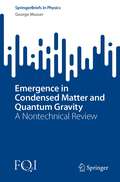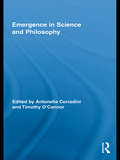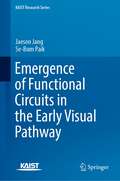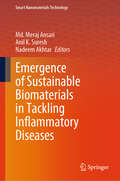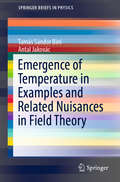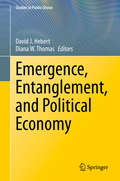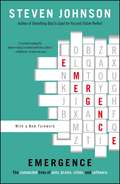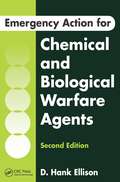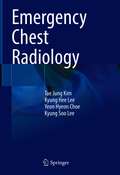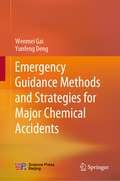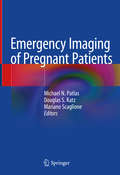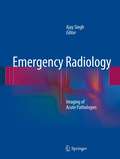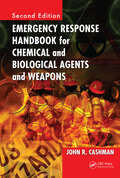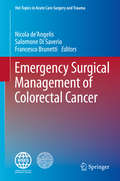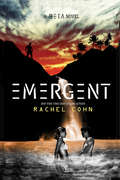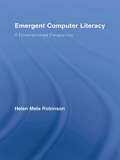- Table View
- List View
Emergence in Condensed Matter and Quantum Gravity: A Nontechnical Review (SpringerBriefs in Physics)
by George MusserThis book surveys the science at a semipopular, Scientific American-level. It is even-handed with regard to competing directions of research and philosophical positions. It is hard to get even two people to agree on anything, yet a million billion water molecules can suddenly and abruptly coordinate to lock themselves into an ice crystal or liberate one another to billow outwards as steam. The marvelous self-organizing capacity of matter is one of the central and deepest puzzles of physics, with implications for all the natural sciences. Physicists in the past century have found a remarkable diversity of phases of matter—and equally remarkable commonalities within that diversity. The pace of discovery has, if anything, only quickened in recent years with the appreciation of quantum phases of matter and so-called topological order. The study of seemingly humdrum materials has made contact with the more exotic realm of quantum gravity, as theorists realize that the spacetime continuum may itself be a phase of some deeper and still unknown constituents. These developments flesh out the sometimes vague concept of the emergence—how exactly it is that complexity begets simplicity.
Emergence in Science and Philosophy (Routledge Studies In The Philosophy Of Science Ser. #6)
by Antonella CorradiniThe concept of emergence has seen a significant resurgence in philosophy and the sciences, yet debates regarding emergentist and reductionist visions of the natural world continue to be hampered by imprecision or ambiguity. Emergent phenomena are said to arise out of and be sustained by more basic phenomena, while at the same time exerting a "top-down" control upon those very sustaining processes. To some critics, this has the air of magic, as it seems to suggest a kind of circular causality. Other critics deem the concept of emergence to be objectionably anti-naturalistic. Objections such as these have led many thinkers to construe emergent phenomena instead as coarse-grained patterns in the world that, while calling for distinctive concepts, do not "disrupt" the ordinary dynamics of the finer-grained (more fundamental) levels. Yet, reconciling emergence with a (presumed) pervasive causal continuity at the fundamental level can seem to deflate emergence of its initially profound significance. This basic problematic is mirrored by similar controversy over how best to characterize the opposite systematizing impulse, most commonly given an equally evocative but vague term, "reductionism." The original essays in this volume help to clarify the alternatives: inadequacies in some older formulations and arguments are exposed and new lines of argument on behalf the two visions are advanced.
Emergence of Functional Circuits in the Early Visual Pathway (KAIST Research Series)
by Jaeson Jang Se-Bum PaikThis book discusses the emergence of diverse functional organizations in the visual pathway which could be spontaneously and solely initiated by the random feedforward wiring of neural circuits. It demonstrates that the structure of ON and OFF retinal ganglion cell (RGC) mosaics is projected onto V1 by retino-cortical feedforward mapping to induce higher cognitive functions. This book will be beneficial for both theoretical and experimental neuroscientists, as well as for researchers using brain-inspired neural network models.
Emergence of In Vitro 3D Systems to Model Human Malaria
by Kasem KulkeawThis book illustrates the importance and advances of the disease model for malaria, a globally affected public health problem. This book provides comprehensive information on the malaria biology in a liver and all in vitro platforms for liver-stage malaria, including principles, protocols, applications for disease modeling and drug screening, and their limitations. The initial chapter describes the basis of stem cells in liver generation during development and in adults. The subsequent chapters highlight recent and emerging advances in liver organoid and liver-on-a-chip in modeling malaria. The book presents current protocols and methods to generate liver organoid and liver-on-a-chip together with their advantages and limitations. Toward the end, the book examines the humanized mouse model of liver-stage malaria using ectopic artificial livers regarding novel readout modalities. The recent advancement and challenges in combining liver-on-a-chip technology with biosensors are highlighted for assessing hepatocyte development viability and functions. The book elucidates the potential of these 3D models to understand the biological complexity of cellular and molecular mechanisms involved in Plasmodium development in the liver, toolboxes to investigate parasite deployment in the 3D models, and to implement in drug discovery. Finally, the book discusses the future directions and challenges in the applications of liver organoids and liver on-chip in the biology of live-stage malaria. This book is helpful for researchers and scientists in the field of parasitology, cell biology, tissue engineering, and pharmacology.
Emergence of Sustainable Biomaterials in Tackling Inflammatory Diseases (Smart Nanomaterials Technology)
by Anil K. Suresh Nadeem Akhtar Md. Meraj AnsariThis book presents the latest technology of sustainable nanomaterials for applications as drug delivery cargos in tackling various inflammatory diseases. The chapters in this book describe nanotechnology-based drug delivery strategies, the mechanistic insights of nanoformulations and their application in managing inflammation diseases such as rheumatoid arthritis, ulcerative colitis, cancer and neurological disorder. It looks into the challenges of using nanomaterials-based smart materials for enhanced therapeutic efficacy while maintaining safe and sustainable procedures. The book is divided into three main sections: A) Fundamental of smart nanocarriers and nanoformulations targeted drug delivery in inflammatory disease; B) Smart nano drug delivery therapy- an emerging approach towards inflammatory diseases and C) Novel nano delivery strategies in targeting major inflammatory diseases. The book targets early researchers and clinical practitioners who are interested in the management and treatment of inflammatory diseases using nanotechnology-based drug delivery systems.
Emergence of Temperature in Examples and Related Nuisances in Field Theory (SpringerBriefs in Physics)
by Antal Jakovác Tamás Sándor BiróField theory, relying on the concept of continuous space and time while confronted with the quantum physical nature of observable quantities, still has some fundamental challenges to face. One such challenge is to understand the emergence of complexity in the behavior of interacting elementary fields, including among other things nontrivial phase structures of elementary matter at high energy density or an atypical emergence of statistical properties, e.g., when an apparent temperature is proportional to a constant acceleration in a homogeneous gravitational field. Most modern textbooks on thermal field theory are mainly concerned with how the field theory formalism should be used if a finite temperature is given. In contrast, this short primer explores how the phenomenon of temperature emerges physically for elementary fields - inquiring about the underlying kinetic field theory and the way energy fluctuations and other noise should be handled - and it investigates whether and how this harmonizes with traditional field theory concepts like spectral evolution, the Keldysh formalism, and phase transitions.
Emergence, Entanglement, and Political Economy (Studies in Public Choice #38)
by Diana W. Thomas David J. HebertThis volume is intended to serve as a review of the “next generation” of political economy scholars in what can be called the “Wagnerian” tradition, which traces its roots to Buchanan and De Viti De Marco in the 1930s, who argued that any decision that results from a political entity must be the product of individual decision makers operating within some framework of formal and informal rules. To treat these decisions as if they were the product of one single mind, or even simply the additive result of several decisions, is to fundamentally misunderstand and mischaracterize the dynamics of collective action. Today, Richard Wagner is among the most prominent theorists in analyzing the institutional foundations of the economy and the organization of political decision-making. In this collection of original essays, former students schooled in this tradition offer emerging insights on public choice theory, public finance, and political economy, across a range of topics from voting behavior to entrepreneurship.
Emergence: The Connected Lives of Ants, Brains, Cities, and Software
by Steven JohnsonIn the tradition of Being Digital and The Tipping Point, Steven Johnson, acclaimed as a "cultural critic with a poet's heart" (The Village Voice), takes readers on an eye-opening journey through emergence theory and its applications.<P> A NEW YORK TIMES NOTABLE BOOK<P> A VOICE LITERARY SUPPLEMENT TOP 25 FAVORITE BOOKS OF THE YEAR<P> AN ESQUIRE MAGAZINE BEST BOOK OF THE YEAR <P> Explaining why the whole is sometimes smarter than the sum of its parts, Johnson presents surprising examples of feedback, self-organization, and adaptive learning. How does a lively neighborhood evolve out of a disconnected group of shopkeepers, bartenders, and real estate developers? How does a media event take on a life of its own? How will new software programs create an intelligent World Wide Web? <P> In the coming years, the power of self-organization -- coupled with the connective technology of the Internet -- will usher in a revolution every bit as significant as the introduction of electricity. Provocative and engaging, Emergence puts you on the front lines of this exciting upheaval in science and thought.
Emergency Action for Chemical and Biological Warfare Agents
by D. Hank EllisonEmergency Action for Chemical and Biological Warfare Agents, Second Edition is intended for the first responder to the scene of the release of a chemical or biological warfare agent. Formatted similarly to the Department of Transportation‘s Emergency Response Guidebook and designed as a companion to the author‘s Handbook of Chemical and Biological
Emergency Care for Birds: A Guide for Veterinary Professionals
by Rob van ZonDue to their often small size and unique physical characteristics, birds can deteriorate rapidly in the event of illness and injury. Timely intervention in the event of clinical signs is therefore essential for an optimal prognosis. Authored by avian veterinarian Rob van Zon, this concise, practical guide will help veterinary professionals to provide first aid and emergency care for birds, as well as to instruct clients on providing basic first aid when they are unable to get to the clinic. This full-color book, packed with photographs and anatomy drawings, includes instructions for veterinary professionals on stabilizing sick avian patients and management of many specific emergency situations at the veterinary clinic. This includes guidance for those presented with a moribund, critically ill patient i.e., recognizing and treating hypothermia, hypoxia, hypovolemia and hypoglycemia. The book also lists of alarming signs of disease and toxic plants, and includes clinical procedures, an emergency drug formulary, and bandaging techniques. Finally, it offers guidance to veterinarians giving advice to bird owners for first aid at home.
Emergency Characterization of Unknown Materials
by William Bennett Rick HoughtonEmergency Characterization of Unknown Materials, Second Edition is fully updated to serve as a portable reference that can be used in the field and laboratory by workers who are responsible for a safe response to and management of unknown hazardous materials. As with the first edition, the book emphasizes public safety and the management of life safety hazards, including strategies and emerging technologies to identify the hazards presented by an unknown material. When responding to a hazardous material emergency involving an unknown substance, firefighters and HAZMAT teams are primarily interested in protecting public safety. The book details risk analysis procedures to identify threats and vulnerabilities, analyzing them to determine how such risks can be eliminated or reduced. If an unknown material can be identified with a high degree of confidence, that can considerably change the response, and measures to be taken. In addition, the book covers practical field applications with updated and additional examples of field instruments. The hazard identification methods presented are intended for use by frontline workers. The test methods presented involve manipulation of small sample amounts – using, literally, a hands-on approach. The three technologies used by first responders and military personnel to identify unknown chemicals, Raman spectroscopy, FTIR spectroscopy and high-pressure mass spectroscopy, are covered in depth. Features Presents how to identify unknown materials and, if identification is not possible, to characterize the hazards of the material Offers practical examples to introduce new first responders to hazardous materials response Provides up-to-date field applications of the latest developments in commercially available instrumentation Details practical sample manipulations to help the reader successfully identify materials with popular high-end instrumentation Includes several examples of spectra and describes ways in which the reader can utilize data to inform decision making New coverage to this edition includes a chapter and content that focuses on sample manipulation and separations using instruments developed and revised since the first edition was published. These sample manipulations may be performed in the field with a very simple toolkit, which is fully outlined and explained in detail. Identifying the hazards of the unknown substance is essential to plan for response, contingencies and sustained actions. As such, Emergency Characterization of Unknown Materials, Second Edition will be a welcome and essential resource to all response and safety professionals concerned with hazardous materials.
Emergency Characterization of Unknown Materials
by Rick HoughtonDeliberately, accidentally, or consequentially, first responders and waste site workers handle unknown substances of varying degrees of danger every day. Unidentified chemicals involved with clandestine production of WMD agents or drugs, explosive materials, unlabeled waste, and forensic samples all pose a threat to the worker and those they prote
Emergency Chest Radiology
by Kyung Soo Lee Kyung Hee Lee Tae Jung Kim Yeon Hyeon ChoeThis book provides an up-to-date, comprehensive review of every aspect of emergency chest radiology in patients who are admitted to emergency departments with chest trauma or chest pain. The aim is to offer an unsurpassed source of practical information on imaging diagnosis of acutely ill and injured patients with this symptomatology. To this end, the wide spectrum of chest and cardiovascular emergencies are systematically categorized and typical imaging manifestations of these emergent conditions are illustrated in superb detail, with particular attention to the role of state of the art imaging techniques. The book will be an ideal resource for all members of the emergency team, general and emergency radiologists, radiology residents, and medical students.
Emergency Guidance Methods and Strategies for Major Chemical Accidents
by Wenmei Gai Yunfeng DengThis book serves as a great reference for engineering technicians and researchers in a wide range of fields, including emergency management, public safety science, risk management, emergency communication, and transportation optimization. This book carried out researches about the public emergency behavior guidance strategies and methods for major chemical accidents. They put forward the classification model of emergency evacuation events, the selection of public emergency guidance strategies, the quantitative assessment of emergency response risk as well as the characteristics of sub-regional evacuation based on a wide range of theories, including safety engineering, social science, behavioral science, etc. Methods, such as case statistics and analysis, field research as well as modeling and simulation, were applied. Five chapters were covered by the book, including introduction of study background, statistics and analysis of hazardous chemical leakage accidents and emergency evacuation response in China in recent ten years, shelter-in-place risk assessment for high-pressure natural gas wells with hydrogen sulphide, dynamic emergency route planning, and characteristics analysis of sub-regional evacuation.
Emergency Imaging of Pregnant Patients
by Mariano Scaglione Douglas S. Katz Michael N. PatlasThis book presents a comprehensive and modern approach to the imaging of nontraumatic and traumatic emergencies in pregnant patients. Readers will find a careful review of the relevant imaging-related clinical literature, explanation of imaging appropriateness criteria and guidelines, and enlightening discussion of current controversies in the emergency imaging of obstetric patients. The opening chapter discusses general principles of emergency imaging during pregnancy and offers an overview of an evidence-based approach to imaging interpretation. The remainder of the book describes specific applications of ultrasound, MRI, radiography, and MDCT for the imaging of common as well as less common acute brain, spine, thoracic, abdominal, and pelvic conditions during pregnancy. Clear guidance is offered on the unique challenges that may be encountered during such imaging. Emergency Imaging of Pregnant Patients is written by a group of leading North American and European emergency and trauma radiology experts. It will be of value to emergency and general radiologists, to emergency department physicians and related personnel, to obstetricians and gynecologists, to general and trauma surgeons, and to trainees in all of these specialties.
Emergency Management and Social Intelligence: A Comprehensive All-Hazards Approach
by Charna R. Epstein Ameya Pawar Scott. C. SimonFor effective preparedness, emergency managers must comprehend how a disaster impacts not only the physical infrastructure of the affected community but also the population. They must understand how the people interact with one another, how they interact with government, and how they react to the disaster event. In other words, they must have socia
Emergency Medicine
by Sean HendersonThis book contains core Emergency Medicine information in an abbreviated, succinct form, useful to house staff and medical students.
Emergency Planning Guide for Utilities
by Jérôme Pagès Samuel Mullen Francois LeAn increase in major natural disasters has led to heightened concerns about utility operations and public safety. Due to today's complex, compliance-based environment, utility managers and planners often find it difficult to plan for the action needed to help ensure organization-wide resilience and meet consumer expectations during these incidents. This volume offers a working guide that presents new and field-tested approaches to plan development, training, exercising, and emergency program management. The book will help utility planners, trainers, and responders to more effectively prepare for damaging events and improve the level of the utility‘s resilience.
Emergency Radiology
by Ajay SinghIn the emergency and trauma setting, accurate and consistent interpretation of imaging studies are critical to the care of acutely ill and injured patients. Emergency Radiology: Imaging of Acute Pathologies is a comprehensive review of radiological diagnoses commonly encountered in the emergency room by radiologists, residents, and fellows. The book is organized by anatomical sections that present the primary ER imaging areas of the acute abdomen, pelvis, thorax, neck, head, brain and spine, and osseous structures. For each section, the common diagnoses are concisely described and are accompanied by relevant clinical facts and key teaching points that emphasize the importance of radiological interpretation in clinical patient management. The role of modalities such as plain radiography, CT, ultrasound, MR, and nuclear medicine imaging in managing emergency conditions is highlighted.
Emergency Radiology of the Abdomen
by Gerd Schueller Mariano Scaglione Ulrich LinsenmaierThe term "acute abdomen" refers to a serious, often progressive clinical situation that calls for immediate diagnostic and therapeutic action. Today, diagnosis via imaging has basically replaced the physical examination in the emergency room and the Radiologist has become of primary importance in this setting. However, close co-operation among the various specialists involved is essential for successful patient management, and thus the Radiologist needs to have a full understanding of the imaging modalities and technical skills required, as well as appropriate clinical knowledge of the disorder in order to manage the condition. This book provides a comprehensive review of the multifaceted etiology, pathophysiology and clinical presentation of acute abdominal conditions, focusing on the imaging features that are relevant to a timely management approach. Numerous high-quality images, diagrams and easy-to-read tables are provided.
Emergency Response Handbook for Chemical and Biological Agents and Weapons
by John R. CashmanUpdated to reflect the numerous advances that have evolved since the September 11 terrorist attacks, Emergency Response Handbook for Chemical and Biological Agents and Weapons, Second Edition maintains its reputation as a comprehensive training manual for emergency responders to incidents involving nuclear, biological, and chemical materials
Emergency Response and Hazardous Chemical Management: Principles and Practices
by Clyde B. Strong T. Rick IrvinManagement of hazardous chemicals and materials-particularly during emergency release situations-is a critical part of routine training required for workers and professionals in the chemical, petroleum and manufacturing industries. Proper storage of highly reactive chemical agents, correct choice of protective clothing and safety issues in confined
Emergency Surgical Management of Colorectal Cancer (Hot Topics in Acute Care Surgery and Trauma)
by Salomone Di Saverio Nicola De'Angelis Francesco BrunettiThis volume provides an overview of the current evidence-based medical and surgical practice in emergency conditions in colorectal cancer patients. It offers a multidisciplinary perspective, taking into account the specific characteristics of colorectal cancer patients, the necessary pre-operative assessment, the endoscopic and radiological management, and the surgical treatments. Each chapter is supplemented with tables, figures, key-point boxes, schematic representations, and decision-making trees that serve as easy-to-use tools to apply in the different scenarios requiring acute care. Recommendations for best practice and the main reference articles are included for each topic, as well as numerous illustrated clinical cases with cilnical and empirical evidence regarding the surgical management of colorectal cancer. Specific technical aspects of the different surgical interventions and approaches (e.g., open surgery, laparoscopy, and robotics) are also detailed. This book is intended for residents and emergency surgeons, as well as all practictioners who treat colorectal cancer patients, such as gastroenterologists, oncologists, and radiologists.
Emergent (A Beta Novel)
by Rachel CohnA clone revolution is brewing.Zhara, the First. Elysia, her clone. On the surface, they are identical. But looks can be deceiving. When Zhara plays, she plays to win. She thought she had escaped the horrors of Doctor Lusardi's cloning compound. But the nightmare is just beginning. Elysia has taken everything from Zhara--a softer, prettier version of herself and an inescapable reminder of all she's failed at in her life. Now the man Zhara loves has replaced her with Elysia. Zhara will get her clone out of the way, no matter the cost. Elysia has finally learned the truth: she has a soul. Her First is alive. She knows it hurts Zhara to see her with Alexander, but she can't give him up. The genetically-perfected Aquine has chosen as her as his life mate, and their days together are limited. Elysia can't remain in the Rave Caves off the shores of Denesme forever. Revolution is brewing on the island paradise. Hundreds of soulless clones remain imprisoned like Elysia once was, slaves to the whims of their owners--wealthy human inhabitants of the island. As a group of clones and humans, led by Alexander, plot an insurrection that will turn Denesme's world upside down, Elysia knows her place is fighting by his side. Terrible sacrifices must be made to defeat Denesme's twisted regime. But even the greatest losses cannot prepare Elysia for the ticking time bomb built into her own programming...
Emergent Computer Literacy: A Developmental Perspective (Routledge Research in Education)
by Helen Mele RobinsonThe United States is currently grappling with how to prepare our students to be computer literate citizens in the competitive technological world we live in. Understanding how children develop computer knowledge, and the ways that adults are able to guide their computer learning experiences, is a vital task facing parents and educators. This groundbreaking book is an attempt to fill a gap in current understanding of how we become computer literate and proposes a theory of how computer literacy skills emerge in computer users.
